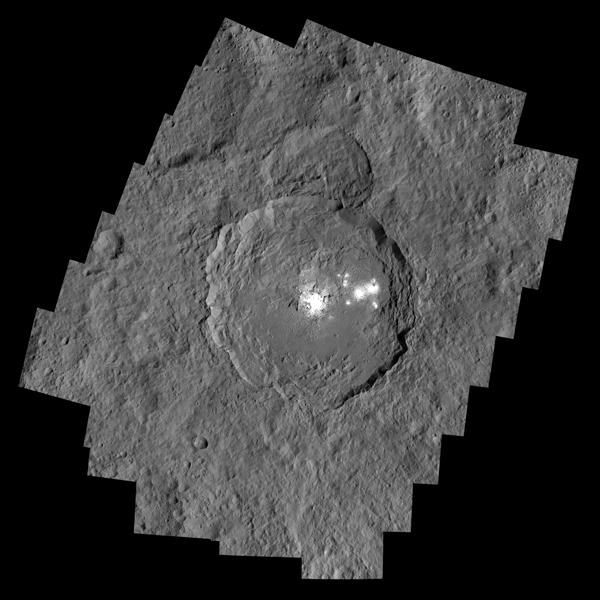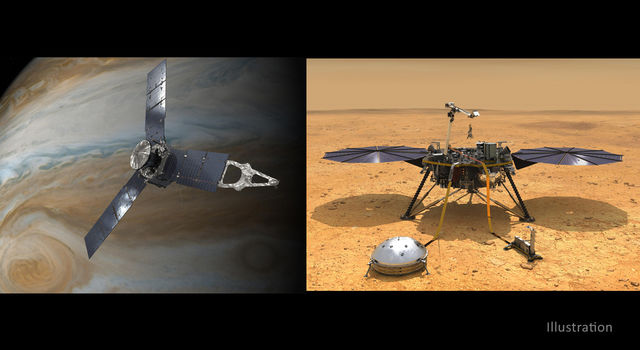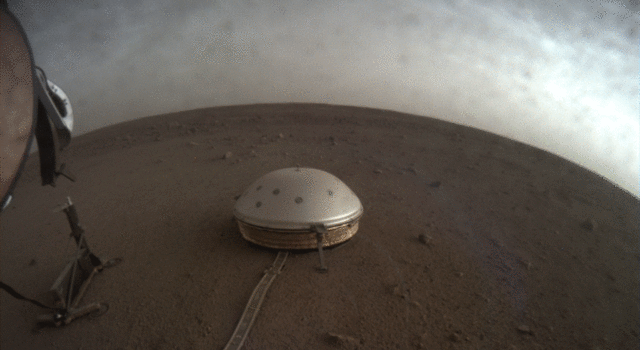Blogs | Dawn Journal | March 31, 2016
Dawn 'Fueled' for Even More Discoveries at Ceres
Dear Resplendawnt Readers,
One year after taking up its new residence in the solar system, Dawn is continuing to witness extraordinary sights on dwarf planet Ceres. The indefatigable explorer is carrying out its intensive campaign of exploration from a tight orbit, circling its gravitational master at an altitude of only 240 miles (385 kilometers).
Even as we marvel at intriguing pictures and other discoveries, scientists are still in the early stages of putting together the pieces of the big puzzle of how (and where) Ceres formed, what its subsequent history has been, what geological processes are still occurring on this alien world and what all that reveals about the solar system.
For many readers who have not visited Ceres on their own, Occator Crater is the most mysterious and captivating feature. (To resolve the mystery of how to pronounce it, listen to the animation below.) As Dawn peered ahead at its destination in the beginning of 2015, the interplanetary traveler observed what appeared to be a bright spot, a shining beacon guiding the way for a ship sailing on the celestial seas. With its mesmerizing glow, the uncharted world beckoned, and Dawn answered the cosmic invitation by venturing in for a closer look, entering into Ceres' gravitational embrace. The latest pictures are one thousand times sharper than those early views. What was not so long ago a single bright spot has now come into focus as a complex distribution of reflective material in a 57-mile (92-kilometer) crater.
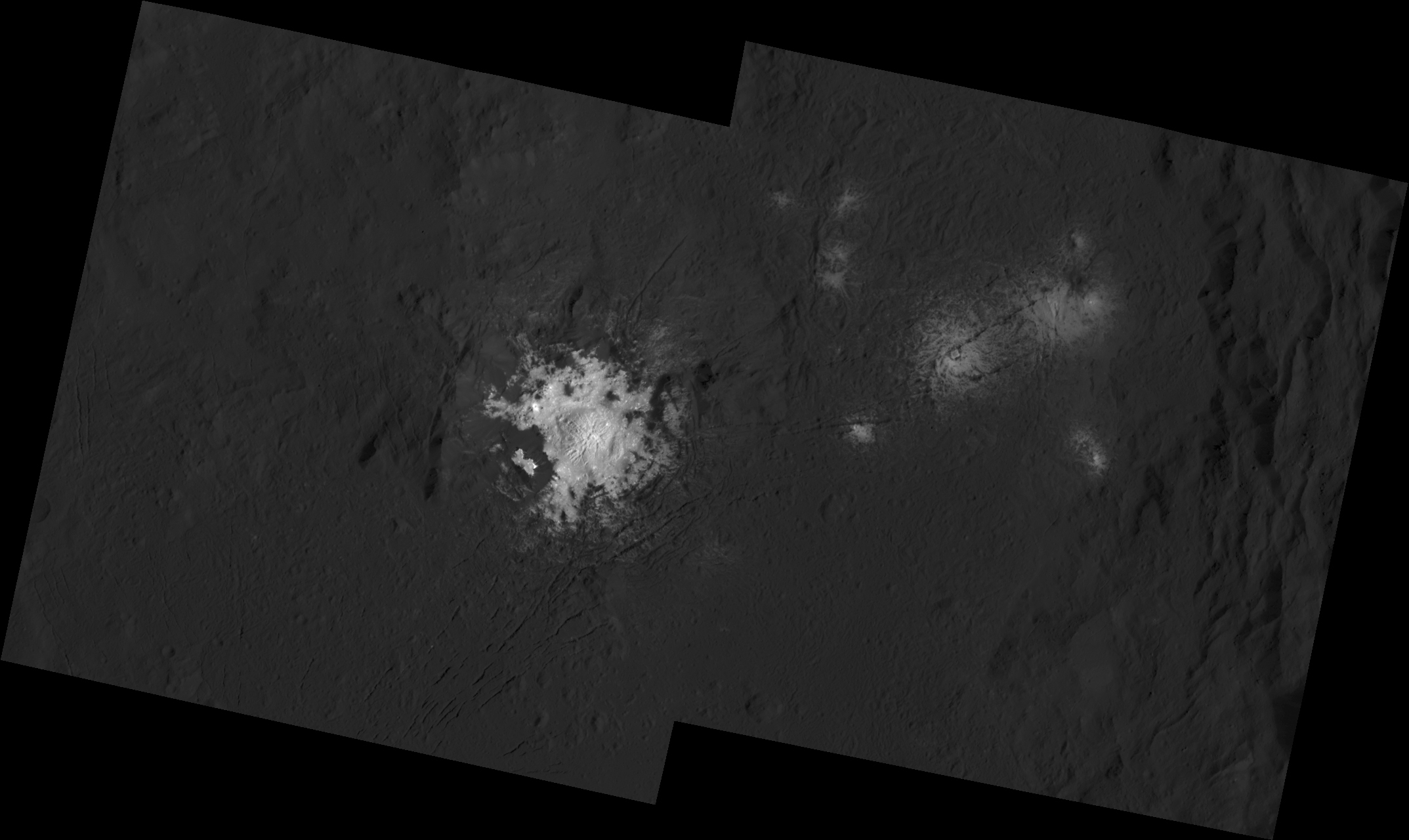
Scientists are still working on refining their understanding of this striking region. As we described in December, it seems that following the powerful impact that excavated Occator Crater, underground briny water reached the surface. The detailed photographs show many fractures cutting across the bright areas, and perhaps they provided a conduit. Water, whether as liquid or ice, would not last long there in the cold vacuum, eventually subliming. When the water molecules disperse, either escaping from Ceres into space or falling back to settle elsewhere, the dissolved salts are left behind. This reflective residue covers the ground, making the spellbinding and beautiful display Dawn now reveals.
While the crater is estimated to be a geological youngster at 80 million years old, that is an extremely long time for the material to remain so reflective. Exposed for so long to cosmic radiation and pelting from the rain of debris from space, it should have darkened. Scientists don't know (yet) what physical process are responsible, but perhaps it was replenished long after the crater itself formed, with more water, carrying dissolved salts, finding its way to the surface. As their analyses of the photos and spectra continue, scientists will gain a clearer picture and be able to answer this and other questions.
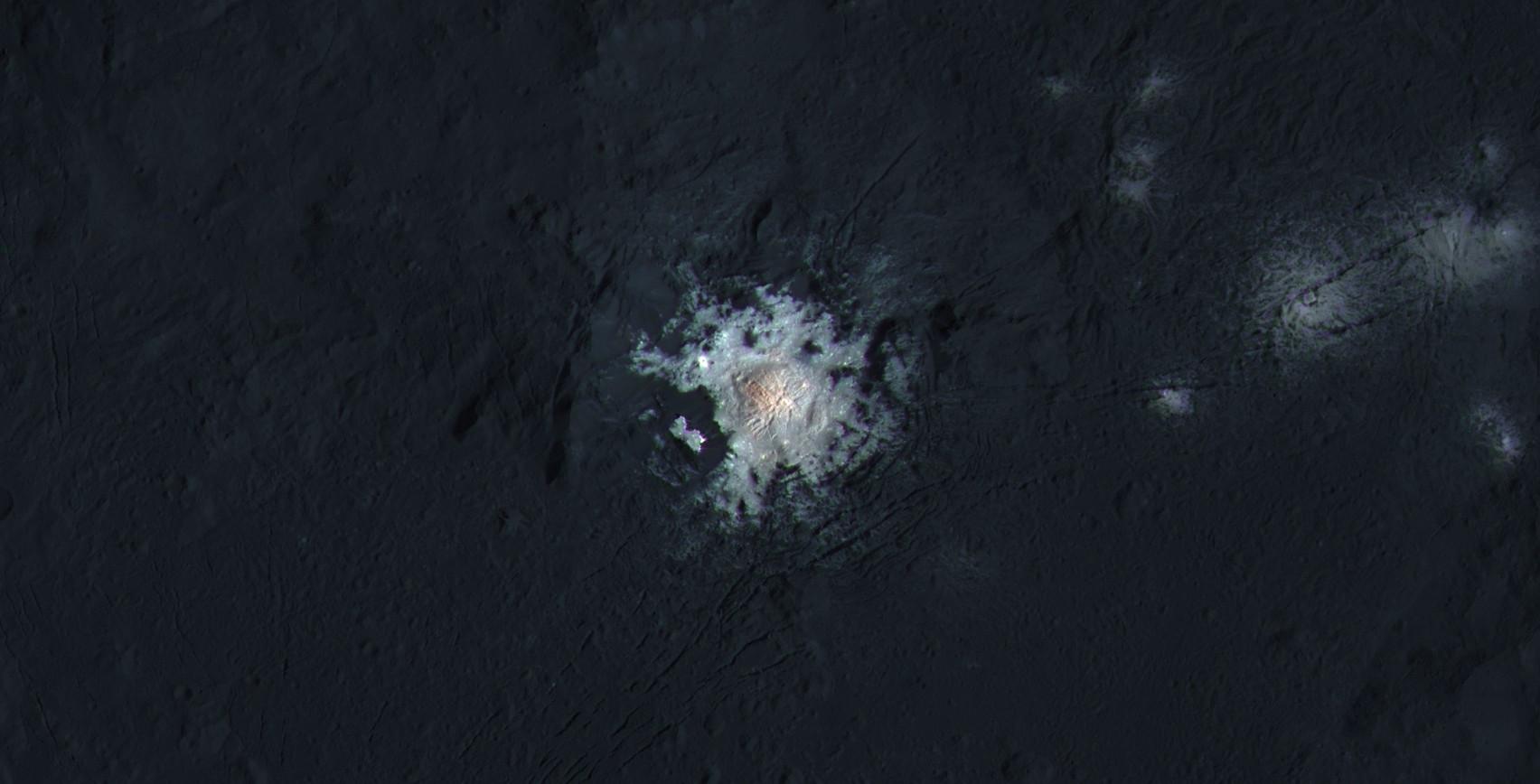
These latest Occator pictures did not come easily. Orbiting so close to Ceres, the adventurer’s camera captures only a small scene at a time, and it is challenging to cover the entirety of the expansive terrain. (Perhaps it comes as a surprise to those who have not read at least a few of the 123 Dawn Journals that precede this one that operating a spacecraft closer to a faraway dwarf planet than the International Space Station is to Earth is not as easy as, say, thinking about it.) But the patience and persistence in photographing the exotic landscapes have paid off handsomely.
We now have high resolution pictures of essentially all of Ceres save the small area around the south pole cloaked in the deep dark of a long winter night. Seasons last longer on Ceres than on Earth, and Dawn may not operate there long enough for the sun to rise at the south pole. By the beginning of southern hemisphere spring in November 2016, Dawn's mission to explore the first dwarf planet discovered may have come to its end.
In addition to photographing Ceres, Dawn conducts many other scientific observations, as we described in December and January. Among the probe's objectives at Ceres is to provide information for scientists to understand how much water is there, where it is, what form it is in and what role it plays in the geology.
We saw that extensive measurements of the faint nuclear radiation can help identify the atomic constituents. While the analysis of the data is complicated, and much more needs to be done, a picture is beginning to emerge from Dawn's neutron spectrometer (part of the gamma ray and neutron detector, GRaND). These subatomic particles are emitted from the nuclei of atoms buried within about a yard (meter) of the surface. Some manage to penetrate the material above them and fly into space, and the helpful ones then meet their fate upon hitting GRaND in orbit above. (Most others, however, will continue to fly through interplanetary space, decaying into a trio of other subatomic particles in less than an hour.) Before it escapes from the ground, a neutron's energy (and, equivalently, its speed) is strongly affected by any encounters with the nuclei of hydrogen atoms (although other atomic interactions can change the energy too). Therefore, the neutron energies can indicate to scientists the abundance of hydrogen. Among the most common forms in which hydrogen is found is water (composed of two hydrogen atoms and one oxygen atom), which can occur as ice or tied up in hydrated minerals.
GRaND shows Ceres is rich in hydrogen. Moreover, it detects more neutrons in an important energy range near the equator than near the poles, likely indicating there is more hydrogen, and hence more (frozen) water, in the ground at the high latitudes. Although Ceres is farther from the sun than Earth, and you would not consider it balmy there, it still receives some warmth. Just as at Earth, the sun's heating is less effective closer to the poles than at low latitudes, so this distribution of ice in the ground may reflect the temperature differences. Where it is warmer, ice close to the surface would have sublimed more quickly, thus depleting the inventory compared to the cooler ground far to the north or south.
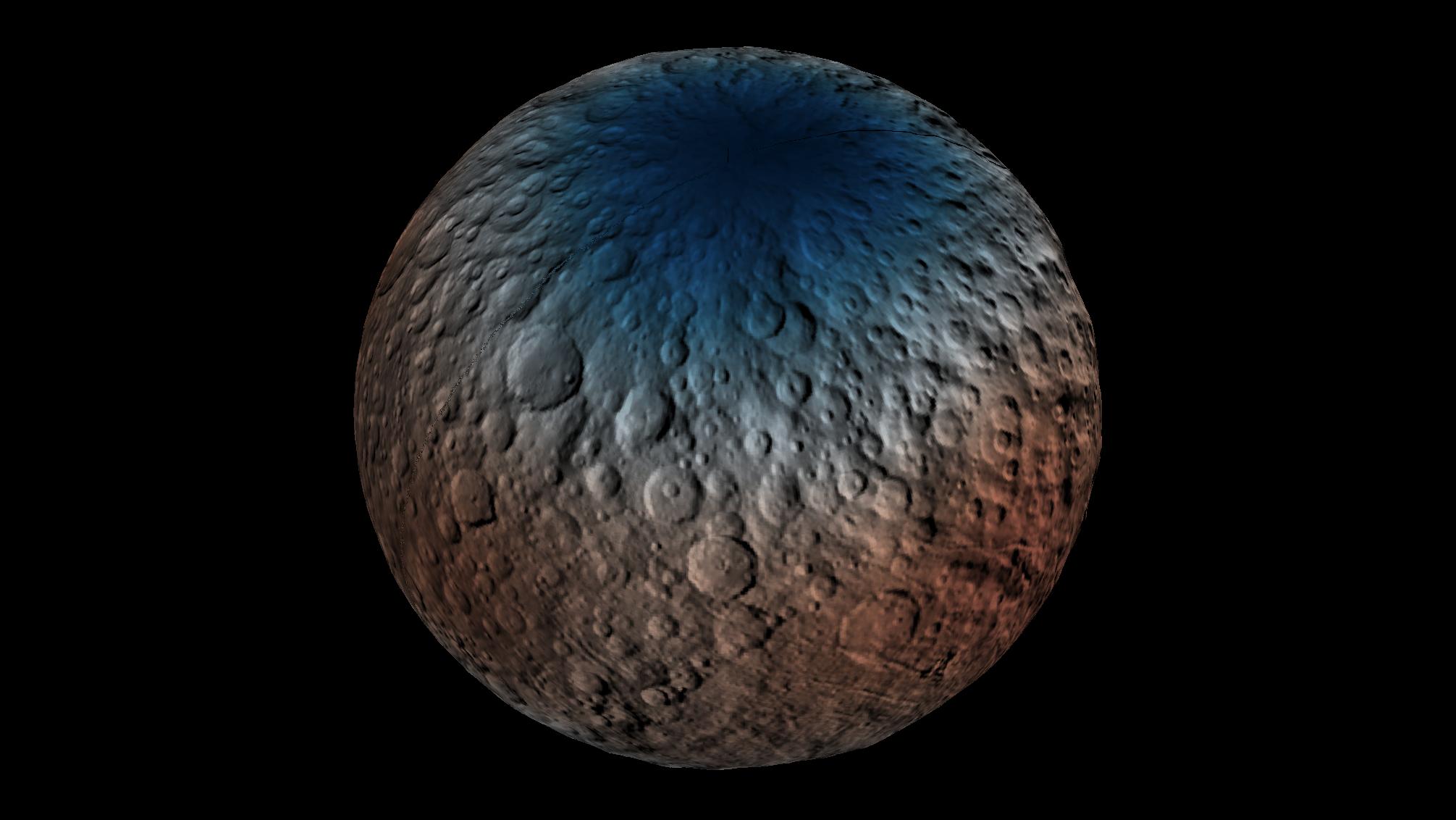
Dawn spends most of its time measuring neutrons (and gamma rays), so it is providing a great deal of new data. And as scientists conduct additional analyses, they will learn more about the ice and other materials beneath the surface.
Another spectrometer is providing more tantalizing clues about the composition of Ceres, which is seen to vary widely. As the dwarf planet is not simply a huge rock but is a geologically active world, it is no surprise that it is not homogeneous. We discussed in December that the infrared mapping spectrometer had shown that minerals known as phyllosilicates are common on Ceres. Further studies of the data show evidence for the presence of two types: ammoniated phyllosilicates (described in December) and magnesium phyllosilicates. Scientists also find evidence of compounds known as carbonates, minerals that contain carbon and oxygen. There is also a dark substance in the mix that has not been identified yet.
And in one place (so far) on Ceres, this spectrometer has directly observed water, not below the surface but on the ground. The infrared signature shows up in a small crater named Oxo. (For the pronunciation, listen to the animation below.) As with the neutron spectra, it is too soon to know whether the water is in the form of ice or is chemically bound up in minerals.
At six miles (10 kilometers) in diameter, Oxo is small in comparison to the largest craters on Ceres, which are more than 25 times wider. (While geologists consider it a small crater, you might not agree if it formed in your backyard. Also note that when we showed Oxo Crater before, the diameter was slightly different. The crater's size has not changed since then, but as we receive sharper pictures, our measurements of feature sizes do change.) Dawn's first orbital destination, the fascinating protoplanet Vesta, is smaller than Ceres and yet has two craters far broader than the largest on Ceres. Based on studies of craters observed throughout the solar system, scientists have established methods of calculating the number and sizes of craters that could be formed on planetary surfaces. Those techniques show that Ceres is deficient in large craters. That is, more should have formed than appear in Dawn's pictures. Many other bodies (including Vesta and the moon) seem to preserve their craters for much longer, so this may be a clue about internal geological processes on Ceres that gradually erase the large craters.
Scientists are still in the initial stages of digesting and absorbing the tremendous wealth of data Dawn has been sending to Earth. The benefit of lingering in orbit (enabled by the remarkable ion propulsion system), rather than being limited to a brief glimpse during a fast flyby, is that the explorer can undertake much more thorough studies, and Dawn is continuing to make new measurements.
As recently as one year ago, controllers (and this writer) had great concern about the spacecraft's longevity given the loss of two reaction wheels, which are used for controlling the ship's orientation. And in 2014, when the flight team worked out the intricate instructions Dawn would follow in this fourth and final mapping orbit, they planned for three months of operation. That was deemed to be more than enough, because Dawn only needed half that time to accomplish the necessary measurements. Experienced spacecraft controllers recognize that there are myriad ways beautiful plans could go awry, so they planned for more time in order to ensure that the objectives would be met even if anomalies occurred. They also were keenly aware that the mission could very well conclude after three months of low altitude operations, with Dawn using up the last of its hydrazine. But their efforts since then to conserve hydrazine proved very effective. In addition, the two remaining wheels have been operating well since they were powered on in December, further reducing the consumption of the precious propellant.
As it turned out, operations have been virtually flawless in this orbit, and the first three months yielded a tremendous bounty, even including some new measurements that had not been part of the original plans. And because the entire mission at Ceres has gone so well, Dawn has not expended as much hydrazine as anticipated.
Dawn is now performing measurements that were not envisioned long in advance but rather developed only in the past two months, when it was apparent that the expedition could continue. And since March 19, Dawn has been following a new strategy to use even less hydrazine. Instead of pointing its sensors straight down at the scenery passing beneath it as the spacecraft orbits and Ceres rotates, the probe looks a little to the left. The angle is only five degrees (equal to the angle the minute hand of a clock moves in only 50 seconds, or less than the interval between adjacent minute tick marks), but that is enough to decrease the use of hydrazine and thus extend the spacecraft's lifetime. (We won't delve into the reason here. But for fellow nerds, it has to do with the alignment of the axes of the operable reaction wheels with the plane in which Dawn rotates to keep its instruments pointed at Ceres and its solar arrays pointed at the sun. The hydrazine saving depends on the wheels' ability to store angular momentum and applies only in hybrid control, not in pure hydrazine control. Have fun figuring out the details. We did!)
The angle is small enough now that the pictures will not look substantially different, but they will provide data that will help determine the topography. (Measurements of gravity and the neutron, gamma ray and infrared spectra are insensitive to this angle.) Dawn took pictures at a variety of angles during the third mapping orbit at Ceres (and in two of the mapping orbits at Vesta, HAMO1 and HAMO2) in order to get stereo views for topography. That worked exceedingly well, and photos from this lower altitude will allow an even finer determination of the three dimensional character of the landscape in selected regions. Beginning on April 11, Dawn will look at a new angle to gain still another perspective. That will actually increase the rate of hydrazine expenditure, but the savings now help make that more affordable. Besides, this is a mission of exploration and discovery, not a mission of hydrazine conservation. We save hydrazine when we can in order to spend it when we need it. Dawn's charge is to use the hydrazine to accomplish important scientific objectives and to pursue bold, exciting goals that lift our spirits and fuel our passion for knowledge and adventure. And that is exactly what it is has done and what it will continue to do.
Dawn is 240 miles (385 kilometers) from Ceres. It is also 3.90 AU (362 million miles, or 583 million kilometers) from Earth, or 1,505 times as far as the moon and 3.90 times as far as the sun today. Radio signals, traveling at the universal limit of the speed of light, take one hour and five minutes to make the round trip.
Dr. Marc D. Rayman
4:00 p.m. PDT March 31, 2016
TAGS:CERES, DAWN, MISSION, SPACECRAFT, VESTA, DWARF PLANET

